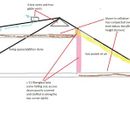Attic Insulation in a Warm-Humid Climate
Hi, I’m looking for some guidance on how to go about properly insulating my attic space. We are in climate zone 4 (kentucky) and the upstairs gets reasonably hot in the summer. After getting into the attic a bit and reading some on here I was hoping to figure out a solution to fix the issues that exist. Some information on the home:
At some point the back of the house had an addition done on the existing roof which extends the length of the home (house was originally built in 1977). When they did this they filled used blown in cellulose to fill the the joist and new ceiling area. It has compacted to about 8″ in some areas and is covering some of the soffits in the back of the home. There is very little space to get into the addition’s attic space. They used R-11 fiberglass batts (maybe R-13) in the stud cavities but it’s falling out and the access doors don’t seal well. I’ve tried to do a sketch of the space and noted the issues.
After reading on here I was considering repairing the fiberglass that was falling out, removing the pieces that were stuffed in the corners, backing the fiberglass with foil faced polyiso 2″ (and maybe extend this up a bit to allow some additional fill to be added), adding baffles to allow airflow between the front and back attic spaces (left and right of the image), and opening up the soffits in the front to allow air to enter. I wasn’t feeling exactly comfortable in doing the work as the discussions about air sealing had me concerned about moister/mold issues.
I’ve had one contractor out and their recommendation is to essentially divide the house in half (2 zones), leaving the addition attic space as is and then redo the right side in the image by removing the insulation that is there and then spraying the roof with open cell foam (I asked why not closed cell and their response was if the roof leaks I would be able to identify it). I recall seeing issues about humid spaces being created with open cell in attics so was going to steer away from it and really and spray foam product to avoid too much chemical exposure with a new born in the house. Any recommendations on this would be greatly appreciated.
VR,
James
GBA Detail Library
A collection of one thousand construction details organized by climate and house part










Replies
Hi James,
Your roof—as so many are—looks challenging when it comes to an insulation retrofit. Although Mike Guertin is a cold-climate builder, this article, Attic Insulation Upgrade, has information pertinent to your situation—particularly the section called “Tune up existing insulation.” I would ask your builder if he intends to do those things too.
Regarding the spray foam: the green building industry regularly recommends open- over closed-cell spray foam because the blowing agents (water or carbon dioxide) are less environmentally polluting compared to closed-cell blowing agents (hydrofluorocarbons or HFCs). You can do the open-cell and address your moisture concerns with an interior vapor retarder.
Kiley,
thanks for the response. I think I have a better handle on this project after reading through a handful of the articles via the link you provided. I'm still not sure on a few aspects of implementation so I try to add a sketch. The main thing I noticed is the recommendation of supply and return air and those being code violations. The articles a bit older from what I can tell so I'll ask my contractor if any updates have been made to allow this (or if you know or anyone else would know).
VR,
James